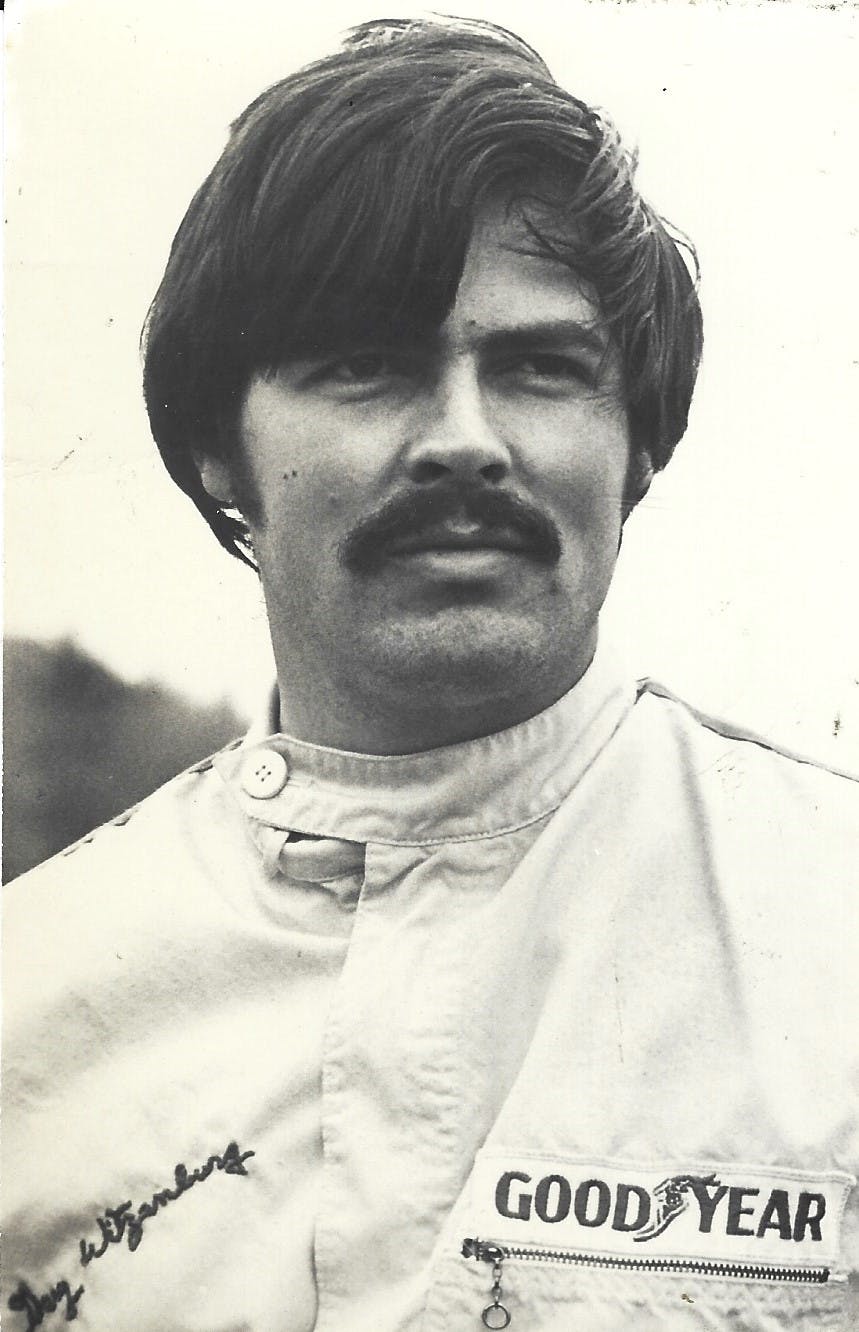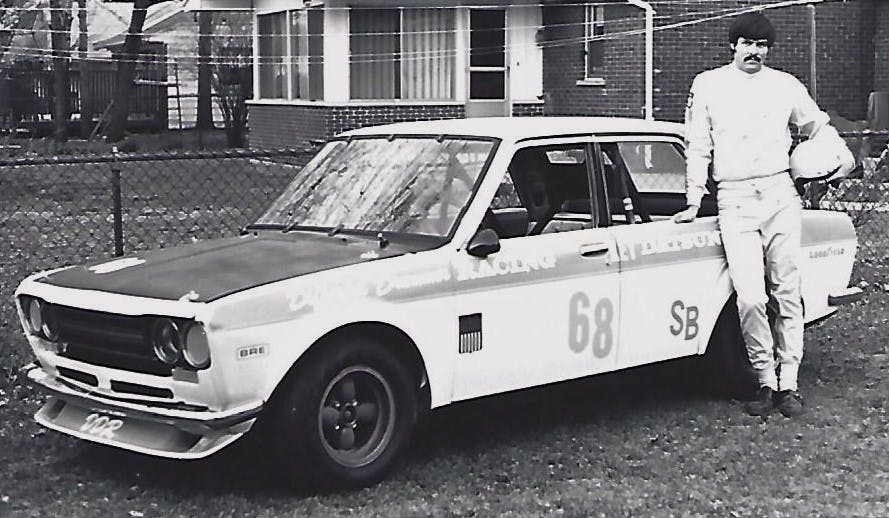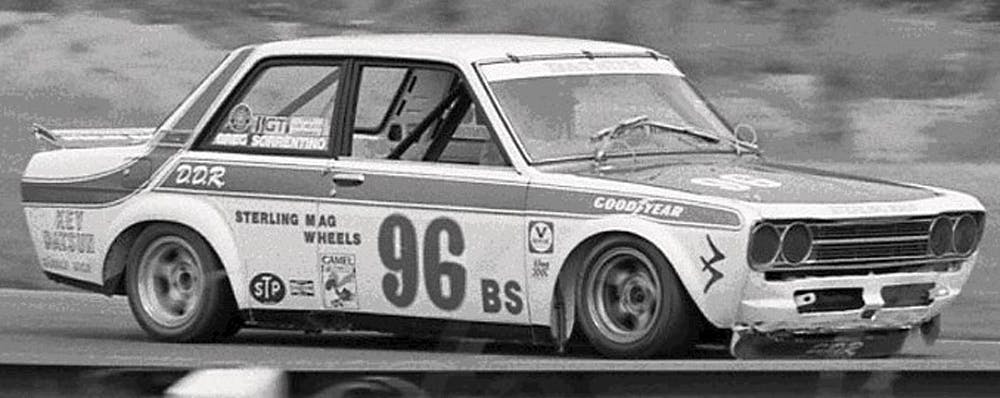Fun with 510s, Part 2: Ratty Road Car to Low-Budget Racer
Editor’s note: This is the second of a two-part story. The first can be found here.
Spring 1972 found us trucking eastward to our first professional race, the May 6 Trans Am 2.5 Challenge Series season opener at Lime Rock Park, CT. We were towing my not-quite-done, totally untested, low-buck SCCA B-Sedan Datsun 510 four-door on my rickety old trailer behind my well-used ’69 Chevy Suburban. What could go wrong?
We got there in time to finish bolting the car together, and rolled it out for my first practice on a fast, tricky track that I had never seen before. And it died in the second turn after just a couple of laps.
Then, while I was leaning, thoroughly disgusted, on my dead 510 at the corner station, a photographer ambled over, introduced himself and snapped a couple of shots of my angry, sleep-deprived face. Why? Literally no one except my hard-working (two-friend) volunteer crew knew who the hell I was or what I was doing there trying to compete with factory and other well-funded teams in this clearly amateur car.

In the photographer’s defense, it did have a decent new paint job that certainly looked the part. That, and as many SCCA-legal upgrades—mostly from factory Datsun racer Peter Brock’s Brock Racing Enterprises (BRE)—as I could afford to install over the course of the prior year’s “rookie” season and the just-ended off-season. Key among those were a BRE competition camshaft, valves and valve springs, an exhaust header and a dual-carb set-up to boost its output to something more than stock but well short of factory-team level. Also, of course, a competition steering wheel, tachometer, gauges and a cheap racing seat.
For handling, I had invested in competition springs, shocks and sway bars, a limited-slip differential, a BRE chin spoiler for front downforce and fender flares for wider wheels and tires. I had talked Goodyear out of a set of racing slicks, which we wrapped around American Mags, and scored product support from Champion Spark Plugs, Valvoline Oil and STP. And I had schmoozed Key Datsun in Warren, Michigan for help with entry fees, parts and service.

We fixed the car in time for qualifying, but my times were less than impressive. We were not the slowest qualifier, but damn close. Datsun treated its Lime Rock 510 racers to a nice dinner that night and passed out press kits with photos. To pile on to the rough start I’d had, there I was in that angry, bleary-eyed, turn two photo along with a shot of our broken car.
I got a decent night’s sleep and felt much better on Sunday, and things improved in the race as I began to get a better feel for the track. Then, a car I was passing on the outside of turn two forced me over the high outside berm, which yanked off our cobbled-up exhaust system. Our stop to wire it up cost us a couple laps, so I drove even harder, trying to gain back time.
I caught dealer/racer George Alderman and pushed him for several laps, gaining on the curves but losing on the long front straight. Finally, I was able to draft him, pull alongside and pass him into turn one . . . because, as it turned out, the checkered flag had flown! He had backed off because our race was over, and in my fixation on his Datsun’s derriere, I had totally missed that. So, I ran an extra hard lap while everyone else was cooling down and pulling in. How embarrassing! Dealer/racer Bob Sharp won in the BRE guest Datsun, Alderman finished seventh, and we ended up 12th out of 28 cars. Not too shabby for our first pro race despite it all.

Brimming with ambition beyond my financial reach (and probably my talent as well), we somehow managed 18 races in that busy season—four 2.5 Challenge pro events, 10 SCCA Nationals, two Regionals, one Waterford Hills club race and a 500-mile endurance contest. After finishing second in a May 13 National at MIS and winning one at Donnybrooke, MN two weeks later, we were leading SCCA Central Division B-Sedan standings. We also won the 500-mile enduro (on BFG street radial tires) at Donnybrooke the next day. Then (as readers of the first part of this story will recall), our second 2.5-Series race at Mid-Ohio brought a surprising last-to-seventh run after the Suburban I was using as a tow vehicle broke down, causing me to miss Saturday’s practice and qualifying.
Our other two 2.5-Series races were July 2 back at Donnybrooke. A blown head gasket on the first lap yielded a hugely disappointing DNF (Did Not Finish), an especially frustrating outcome given the exhausting 18-hour drive (alone, with no crew) up there from Detroit. July 16 found us at Road America, where we finished a respectable eighth despite an off-song engine. But as the season progressed, our primary goal of earning an invitation to the SCCA’s November American Road Race of Champions (ARRC) National Championship Runoff races at Road Atlanta in our first year of National competition became increasingly less attainable as the B-Sedan class grew ever larger and more competitive, largely because of the 2.5 Challenge pro series.
And that aspiration suffered a major setback in a Regional race at Grattan when my right front tire’s sidewall was ripped open by a jagged pothole at the apex of the fast right-hander that is the second-to-last turn. Rendered rudderless and without grip enough to brake, I was unable to avoid a hard, head-on meeting with the front-straight guardrail. The hit was hard enough that it tore that section’s wooden posts out of the ground and moved the armco back several feet. Good thing they weren’t steel posts imbedded in concrete! I was thankfully okay, but the front of my 510 was a mangled mess.

Why were we running a no-points Regional while working so hard to make the National Run-Offs? I guess because I knew and loved Grattan, and a win would earn a much-needed $100 contingency award from Datsun. I was leading handily in class at that tricky track, and running third overall behind a Corvette and an A-Sedan Camaro, when the wreck happened.

Friend and fellow 510 racer Greg Sorrentino generously lent us his (much better) car for a Mid-Ohio National, where we finished a sad seventh (one position out of the points) in the rain with a series of frustrating problems after qualifying fourth. Then I drove Greg’s car in a Waterford Hills club race to a challenging second, trying hard but unable to pass the leader on a very greasy track.

All told, we ran eight more Nationals after that somewhat encouraging June Mid-Ohio 2.5 race, resulting in zero wins and just two top fives. Mechanical problems—including one blown-clutch DNF and one engine issue DNS (Did Not Start)—ruined two and hurt some of those races, and we missed that coveted Runoffs invitation by just two points. We sure wished we had time and budget to tear down, inspect, thoroughly prepare and test our car and engine between races like well-funded teams did. But we didn’t. All we could do was fix what broke and move on.
Especially frustrating was our last 1972 National at Indianapolis Raceway Park, back in my own 510, which Key Datsun’s body shop had banged back together. A finish of fourth or better would have boosted us over the line for that Runoffs ticket, but while running well on the way to a good result, a car I had been pushing and trying hard to pass blew its engine and spun in front of me in its own oil. I managed to miss it, but my windshield was covered with oil, my wipers made it worse, and I could barely see to find my way to the pits. The necessary stop to clean my windscreen dropped us to a lowly eighth-place finish, well out of the points.
It was a very busy, tough, often fun, too-often frustrating rookie SCCA National/pro season that did see us make some respectable runs despite our inexperience and tiny budget. In addition to all that racing while holding down my regular job, I earned a few extra bucks by buying used 510s—first a sedan, then a wagon—that needed body and other repairs, fixing them up and reselling them. And both served as daily drivers while I had them, giving me more positive feelings about those tough little cars, even in routine street usage.

My now-well-used 510 racer got a new white-on-blue paint job and a few more upgrades for 1973, and I invested in a new ’73 Suburban to tow it. But then I decided to leave GM for my first writing job as engineering editor at Reno, NV-based Competition Press (which later evolved into Autoweek and moved to Detroit), and that weekly paper’s publisher, Russ Goebel, didn’t allow any of his staffers to race. I would have to sell my car and quit racing. It was a tough decision!
But, still single at that point, I pulled up stakes and moved to Reno, where I unfortunately soon ran into issues with the editorial director at my new gig. I had left the 510 in Michigan with plans to tow it to Reno and sell it there as soon as possible, but a press trip back to Detroit offered an opportunity for one last just-for-fun Regional race at Grattan, where I finished fourth. I then took vacation time to tow it out to Reno, and when I reported back to work, I was summarily fired. No excuses, no discussion. Just, “Clean out your desk. You’re done!” I’d later learn that the director had a long reputation for such behavior, but it was time to start fresh in a still-new-to-me place.
I found a job there selling Toyotas (easy to sell, hard to get in fuel-crisis 1973), and after a few months was very thankfully offered a writing job back in Detroit by Wards Auto World editor Dave Smith. I towed the 510 back through January ice and snow and eventually sold it to a young man heading for his first SCCA driver’s school. I never kept track of him or my once-loved 510 but heard later that he had crashed it. Too bad for him, and for that veteran car.
All things considered, I could not have made a better choice than to invest my limited time, energy and budget in that car, that class and that pro series for maximum grins per dollar. My two seasons with it could have gone much better, but could have also been a lot worse. And, thanks to Brock and many other talented 510 racers, including Bob Sharp and actor Paul Newman, what an iconic little “economy” car that plain-Jane 510 turned out to be both on and off the track.
***
Check out the Hagerty Media homepage so you don’t miss a single story, or better yet, bookmark it. To get our best stories delivered right to your inbox, subscribe to our newsletters.



What a great story.
Thanks.
Was the 2 door much different from the 4 door on the race track.
I always envied the 2 door guys when I was racing my 4 door but I never got a chance to try a 2 door.
I imagine you are like me and wish you[‘d been able to hang onto your 510 no matter how many doors it had.
As you read, I raced friend Greg Sorrentino’s (#96) 510 a few times, and it was a much more professionally built car than mine so better in solidity and feel. But I didn’t attribute much difference to 2-door vs. 4-door. The 2-door looked better and might have been slightly lighter but very similar otherwise. I did love my low-budget 510 but chose to sell it to go a different direction after the 2.5 Series went away. I chose Formula Ford — great fun to drive and (as you know) a highly competitive class — and ran that for three years before investing with my then-girlfriend (now wife) in a well-built Datsun 710 for IMSA RS pro racing. A story for another time.
Here’s my second Witz encounter. Sometime late 1990s. We were both back at GM. Crossed paths at a Milford PG drive event for execs and various domos. I was at Allison in Indianapolis and came with a big red GMC dually pickup that prototyped the Duramax / Allison powertrain that went into production in the HD pickups in MY 01. I think you were doing electric drive stuff at that point and got me a ride in the very fun EV1.
Hi Bill,
Thank you for this second recollection. Yes, I was Vehicle Test and Development manager for GM Advanced Technology Vehicles through most of the ’90s. I don’t recall that specific incident, but we did a lot of those demo drives, so glad you got a ride in the EV1. Maybe if I knew your last name…. You can reach me through my website if you would like to: https://www.witzwrites.com.
Great stories. Wonder if the rules allowed a rear spoiler on the trunk in 1972. My 510 race car has one I salvaged from a Subaru sedan. Haven’t raced since Covid hit and wondering if I’ll keep going with it.
Nope. No rear spoiler.
Glad the accident was not a life changing thing beyond losing the car. I think you had maximum fun and that is important.
I loved the stories. I have been a big fan of 510s. While in Vietnam in 1971, I read a story in Car and Driver about the 510 which intrigued me. I bought one through a military program when I came home in ’72. My motorsport was autocross and I did all the typical suspension and limited slip diff stuff. I was even able to purchase and have installed a former factory rally car engine with the dual Mikuni-Solex carbs. It had 125 horse power with a 7000 RPM redline. In my local events here in Utah I did pretty well, taking Fast-Time-of the-Day trophies. A friend, who auto crossed his VW Sirocco, bought it from me in ’74 or ’75. I later heard it was sold to a guy who turned into a mini-stock circle track car. I have dreams about that car and often wonder what became of it.
Had a 72 Datsun 510 4 dr that dual point distributor drove me crazy I didn’t really know much about auto mechanics back then and it showed but I bought it cheap and gas was 50 cents a gallon unfortunately I rolled it over and destroyed it but I’m still here so they’re not the deathtraps everyone used to call foreign cars.
Gary,
Good to see you writing again. Good to hear from you at all. I read the first installment and told myself, that must be Gary’ 4 dr 510. Great stories, maybe I will make some later ones. Thanks for reminding me about the Different Drummer times. Keep up the good work.
Hi Bob,
Thank you for this comment and your kind words. I stopped racing in 1992 (except for some LeMons and ChampCar 24-Hour co-drives in 2020) but have never stopped writing except for a15-year break 1987-2002 when I had a real (non-writing) job. Good to hear from you as well.
Ah Witz – quite the racey stud:>)